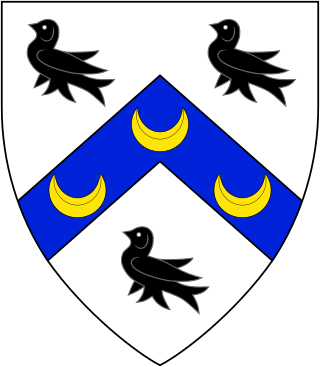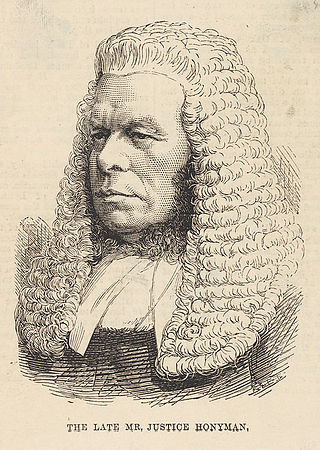
The Bunbury Baronetcy, of Bunbury, Oxon and Stanney Hall in the County of Chester, is a title in the Baronetage of England. It was created on 29 June 1681 for Thomas Bunbury, Sheriff of Cheshire from 1673 to 1674 and the member of an ancient Cheshire family. His grandson, Henry, the third Baronet, and great-grandson, the fourth Baronet, both sat as Members of Parliament for Chester. The latter died unmarried at an early age and was succeeded by his younger brother, the fifth Baronet. He was a clergyman. On his death in 1764 the title passed to his eldest son, the sixth Baronet. He represented Suffolk in the House of Commons for over forty years but is best remembered for his marriage to Lady Sarah Lennox. He died childless in 1821 and was succeeded by his nephew, the seventh Baronet. He was the son of Henry Bunbury, younger son of the fifth Baronet. The seventh Baronet was a distinguished soldier and politician. His eldest son, the eighth Baronet, was High Sheriff of Suffolk in 1868, and Fellow of the Royal Society. He died childless in 1886 and was succeeded by his younger brother, the ninth Baronet. He was Liberal Member of Parliament for Bury St Edmunds. He died unmarried in 1895 and was succeeded by his nephew, the tenth Baronet. He was the son of Colonel Henry William St Pierre Bunbury, third son of the seventh Baronet. He served as High Sheriff of Suffolk in 1908 and was a Deputy Lieutenant of the county. On his death in 1930 the title passed to his son, the eleventh Baronet. He was High Sheriff of Suffolk in 1936 and was a Deputy Lieutenant of the county. His son, the twelfth Baronet, was High Sheriff of Suffolk in 1972. As of 2014 the title was held by the latter's second but eldest surviving son, the thirteenth Baronet, who succeeded in 1985.

The Bagge Baronetcy, of Stradsett Hall in the County of Norfolk, is a title in the Baronetage of the United Kingdom. It was created on 13 April 1867 for William Bagge, Conservative Member of Parliament for West Norfolk. The sixth Baronet was Chairman of the West Norfolk District Council between 1976 and 1977.

The Macgregor Baronetcy, of Savile Row in the County of Middlesex, is a title in the Baronetage of the United Kingdom. It was created on 17 March 1828 for Patrick Macgregor, Serjeant-Surgeon to King George IV. Charles Reginald Macgregor (1847–1902), second son of the third Baronet, was a Brigadier-General in the Army.
The Goold Baronetcy, of Old Court in the County of Cork, is a title in the Baronetage of the United Kingdom. It was created on 8 August 1801 for Francis Goold, with remainder to the heirs male of his father Henry Michael Goold, who gave valuable service to the government of King George III. The Goold family descends from William Gould, who served as Mayor of Cork during the reign of King Henry VII. His descendant George Gould changed the spelling of the surname to Goold. He was the father of Henry Michael Goold and the grandfather of the first Baronet.

The Medlycott Baronetcy, of Ven House in the County of Somerset, was a title in the Baronetage of the United Kingdom. It was created on 3 October 1808 for William Medlycott, Member of Parliament for Milborne Port from 1790 to 1791. The family descended from James Medlycott, of Ven House, who represented Milborne Port in the House of Commons between 1710 and 1722. His son Thomas Medlycott died without surviving male issue in 1763 and left his estates to his maternal nephew Thomas Hutchings, who adopted the surname of Medlycott. His son was the first Baronet. The baronetcy became extinct with the death of the 9th Baronet in 2021.

The Leeds Baronetcy, of Croxton Park in the County of Cambridge, is a title in the Baronetage of the United Kingdom. It was created on 31 December 1812 for George Leeds. He was an equerry to Prince Augustus Frederick, Duke of Sussex. The Croxton Park estate in Cambridgeshire had been in the Leeds family since circa 1568. As of 2011 the presumed ninth and present Baronet, a resident of Canada, has not successfully proven his succession and is not on the Official Roll of the Baronetage.

There have been seven baronetcies created for persons with the surname Watson, one in the Baronetage of England, one in the Baronetage of Great Britain and five in the Baronetage of the United Kingdom. One creation is extant as of 2016.

The Wraxall Baronetcy, of Wraxall in the County of Somerset, is a title in the Baronetage of the United Kingdom. It was created on 21 December 1813 for Nathaniel Wraxall. He was in the East India Company Civil Service, an author and member of parliament for Hindon, Ludgershall and Wallingford. His grandson, the third Baronet, was an author.
There have been three baronetcies created for people with the surname Riddell, one in the Baronetage of Nova Scotia, one in the Baronetage of Great Britain and one in the Baronetage of the United Kingdom. As of 2014 one creation is extant.

The Lockhart, later Lockhart-Ross Baronetcy, of Carstairs in the County of Lanark, was a title in the Baronetage of Nova Scotia.

The Puleston Baronetcy, of Emral in the County of Flint, was a title in the Baronetage of the United Kingdom. It was created on 2 November 1813 for Richard Parry Price, heir to the Puleston estates, who changed his surname accordingly. The title became extinct on the death of the fourth Baronet in 1896.

The Honyman Baronetcy, of Armadale in the County of Orkney, was a title in the Baronetage of the United Kingdom. It was created on 19 May 1804 for William Honyman, a Lord of Session under the judicial title Lord Armadale. The second Baronet sat as Member of Parliament for Orkney. The fourth Baronet was a Judge of the Court of Common Pleas. The title became extinct on the death of the fifth Baronet in 1911.
The Hoste Baronetcy, of the Navy, was a title in the Baronetage of the United Kingdom. It was created on 21 September 1814 for the naval commander Captain William Hoste. The title became extinct on the death of the fourth Baronet in 1915.

The Broke, later Broke–Middleton Baronetcy, of Broke Hall in the County of Suffolk, was a title in the Baronetage of the United Kingdom. It was created on 2 November 1813 for Philip Broke, a Rear-Admiral of the Royal Navy. He was the grandson of Robert Broke, nephew of Sir Robert Broke, 1st Baronet, of Nacton, who were both descended from Sir Richard Broke, Chief Baron of the Exchequer during the reign of Henry VIII. The second Baronet was Sheriff of Suffolk in 1844 and his younger brother the third Baronet was Sheriff of Suffolk in 1864. The third Baronet assumed the additional surname of Middleton in 1860 after inheriting the estate of his cousin Sir William Fowle Fowle-Middleton. The title became extinct on his death in 1887.
The Domville Baronetcy, of St Alban's in the County of Hertford, was a title in the Baronetage of the United Kingdom. It was created on 28 July 1814 for William Domville, Lord Mayor of London from 1813 to 1814. He was a descendant of William Domville, elder brother of Gilbert Domvile, ancestor of the Domvile baronets of Tempoleogue. The title became extinct on the death of the seventh Baronet in 1981.
The Palmer Baronetcy, of Castle Lackin in the County of Mayo, was created in the Baronetage of Ireland on 29 May 1777 for Roger Palmer. The fifth Baronet sat as Member of Parliament for County Mayo. The title became extinct on his death in 1910.

The Stewart baronetcy, of Ramelton in the County of Donegal, was created in the Baronetage of Ireland on 2 May 1623 for the soldier William Stewart.
The Maxwell baronetcy of Cardoness, Kirkcudbrightshire, was created on 9 June 1804 in the Baronetage of the United Kingdom for David Maxwell.

The Fraser Baronetcy, of Ledeclune in the County of Inverness, was created in the Baronetage of the United Kingdom on 27 November 1806 for William Fraser. The third Baronet served with the 7th Hussars in Spain during the Peninsular War, and was on the staff of the Duke of Wellington during the Waterloo Campaign. The fourth Baronet was an author and collector and also represented Barnstaple, Ludlow and Kidderminster in the House of Commons. The fifth Baronet sat as Member of Parliament for Harborough.

The Smith baronetcy of Eardiston, Worcestershire was created on 23 September 1809 in the Baronetage of the United Kingdom for William Smith.














